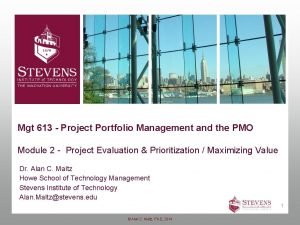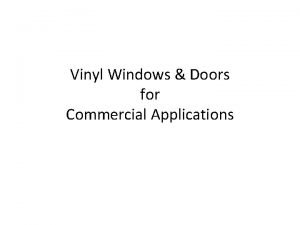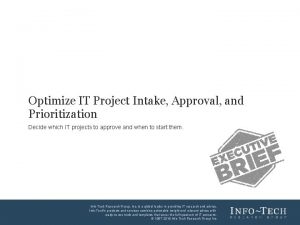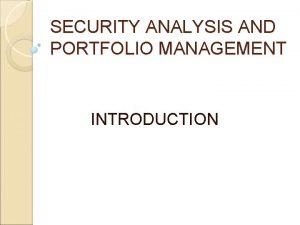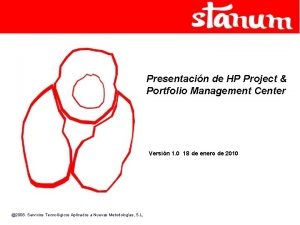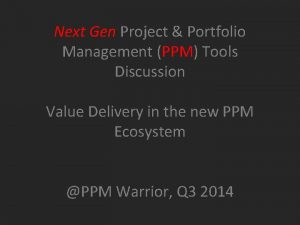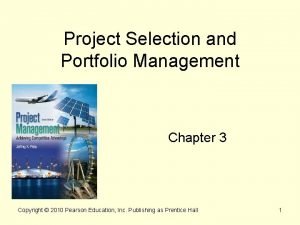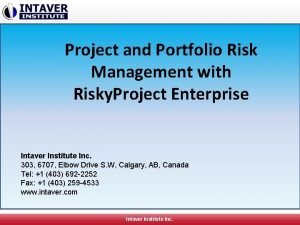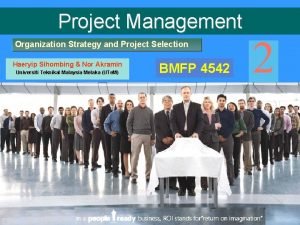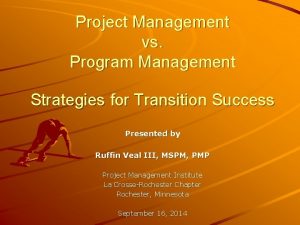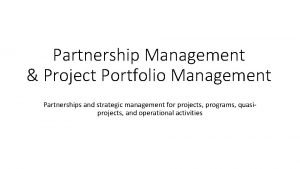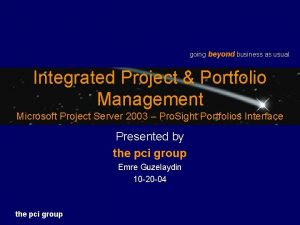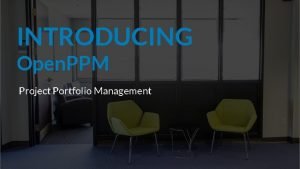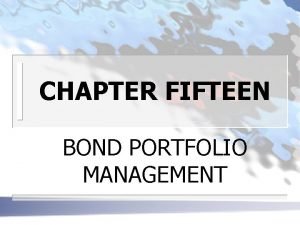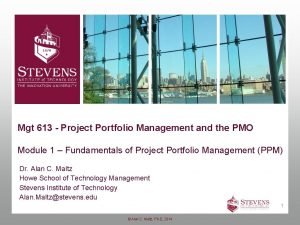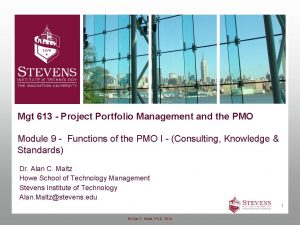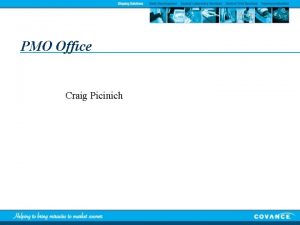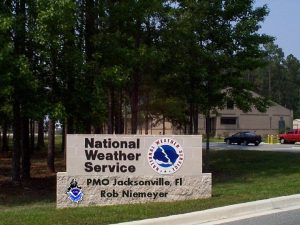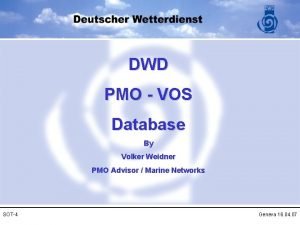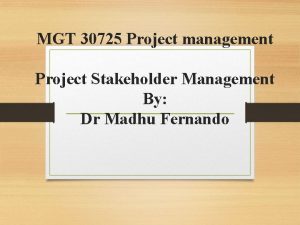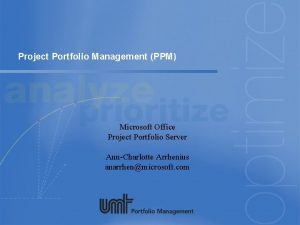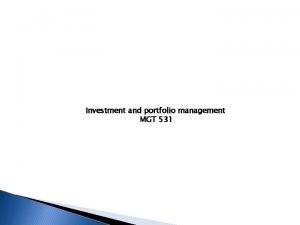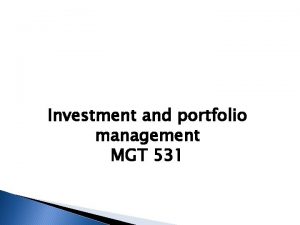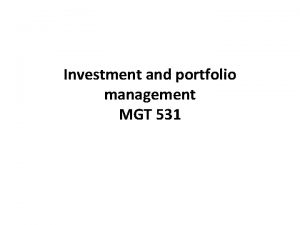Mgt 613 Project Portfolio Management and the PMO



















- Slides: 19

Mgt 613 - Project Portfolio Management and the PMO Module 6 - Monitoring and Controlling the PPM Portfolio Dr. Alan C. Maltz Howe School of Technology Management Stevens Institute of Technology Alan. Maltz@stevens. edu 1 © Alan C. Maltz, Ph. D, 2014

This Week’s PPM Focuses on Portfolio overview – review and monitoring of existing portfolio and introduces, discusses and analyzes the Stage-Gate Process versus standard portfolio reviews 2 © Alan C. Maltz, Ph. D, 2014

Portfolio management process (adapted PMI 2013) Portfolio Management Processes Strategic Planning Process Output: Current Strategic Plan Aligning Process Group Identification Monitoring and Controlling Process Group Component Processes Component Execution and Reporting Prioritization Current Strategic Plan l. Goals Definitions & Categorization Categories Portfolio Reporting and Review (3. 2. 2. 1) Portfolio Balancing l. Key Performance Criteria l. Capacity Definition Evaluation Authorization Strategic Change No Selection Yes v PPM links with strategy v PPM is a continuous business process 3 © Alan C. Maltz, Ph. D, 2014

Portfolio reporting and review To gather performance indicators, provide reporting on them, and review the portfolio at an appropriate predetermined frequency, to ensure both alignment with the organizational strategy and effective resource utilization To ensure that the portfolio contains only components that support achievement of the strategic goals 4 © Alan C. Maltz, Ph. D, 2014

PPM and the Organization Context. . . Vision, Mission Strategic Planning Strategic Operations Portfolio Performance Review Objective s Project Portfolio Management Program Identification, Categorization, Evaluation, Selection, Prioritization, Balance and Authorization of Portfolio Components Request s Delivering Completed Project/Program to Operations Project/Progra m Mgt Project/Program Management Processes © Alan C. Maltz, Ph. D, 2014 Project/Program Performance Review 5

Goals of Effective PPM… Maximizing portfolio value • Financial Models • Scoring Models Balance in the portfolio • Risk vs reward • Use of bubble diagrams Link to strategy • Top-down • Bottom-up • Hybrid 6 © Alan C. Maltz, Ph. D, 2014

Strategic changes To enable the portfolio management process to respond to changes in strategy. Many companies use the Stage-Gate process to drive new products from idea to market 7 © Alan C. Maltz, Ph. D, 2014

Integration between Gate and Portfolio Decisions. . Portfolio Review: Business Strategy & New Product Strategy Stage-Gate Process: This meeting… – Reviews all the projects together – Identifies strategic imperatives – Checks project priorities – Checks for portfolio balance Made periodically Project status & Scores Decisions & adjustments Potential conflict All gates, projects… – Must pass Must Meet criteria – Are scored on Should Meet criteria – Have Go/Kill decisions made Made in real-time 8 © Alan C. Maltz, Ph. D, 2014

Portfolio reviews Approach 1: Gates dominate • “make sound decisions at the gates and the portfolio will take care of itself” Approach 2: Portfolio reviews dominate • “merely being in the portfolio does not guarantee funding” 9 © Alan C. Maltz, Ph. D, 2014

A Typical Stage-Gate. TM Process Driving New Products to Market Discovery Idea Screen Gate 1 Stage 1 Scoping Second Screen Gate 2 Go To Development Stage 2 Build Business Case Gate 3 Go To Testing Stage 3 Development Gate 4 Go To Launch Stage 4 Testing & Validation Gate 5 Stage 5 Launch Post-Launch Review 10 © Alan C. Maltz, Ph. D, 2014

Gates dominate… Pass/Kill Project is evaluated against Must Meet & Should Meet Criteria Does the Project Pass hurdles? Pass Prioritization: How does the project compare to Active & On Hold projects. Resources are allocated. Kill Go – is resourced; becomes Active Project Placed On Hold 11 © Alan C. Maltz, Ph. D, 2014

Gate dominate. . . Focus on project management process— Real-time decision process Each project is reviewed in-depth at the gates Go/kill decisions are made Project is prioritized— Ranking the project with other active and on hold projects Resources are allocated Impact of the project on the total portfolio is accessed— Balance and alignment If the gating process is working well, the portfolio will take care of itself! Still portfolio reviews are needed— senior management may meet once or twice a year to review the portfolio of all projects 12 © Alan C. Maltz, Ph. D, 2014

Portfolio Review Strategic imperatives: Check for must do projects Check for project priorities: Prioritized scored list of active & on hold projects Business Strategy & New Product Strategy Check List: Project subjected to “Must Meet” criteria ? List of Projects: Active & On-Hold Project Scores from Gates Check for strategic alignment & balance: bubble diagrams & charts Adjust the gating scheme Stage-Gate Process Scoring Model Project scored on “should Meet” rating criteria Check for impact on portfolio ? Strategic imperatives (Must Do Now) Prioritization Adjustments Pass or Kill Go or Hold Priority set Projects are prioritized & resources allocated: -from other projects at/near gates – from other sources 13 © Alan C. Maltz, Ph. D, 2014

Portfolio reviews dominate Go/kill and prioritization decisions are made at the portfolio reviews— 3 -4 times a year All projects are up for consideration— projects compete against each others Balance and strategic alignment are checked Gates serve as checks on project status 14 © Alan C. Maltz, Ph. D, 2014

Portfolio Management intersecting with NPD… Portfolio Review – Mass Gate 2 Business Strategy & New Product Strategy l All projects are up for auction l Must Do’s identified l Won’t Do’s killed l The Rest are force-ranked on criteria & prioritized l Resources are allocated Gate 1 Ideation Stage 1 Preliminary Investigation Gate 2 Stage-Gate Process Stage 2 Detailed Investigation (Build Business Case) Gate 3 Stage 3 Development Gate 4 Stage 4 Testing & Validation Gate 5 Stage 5 Full Production & Market Launch 15 © Alan C. Maltz, Ph. D, 2014

A Commercial System – Project Performance Managemen Powersteering© by UPLAND 16 © Alan C. Maltz, Ph. D, 2014

A Commercial System – Project Performance Managemen Powersteering© by UPLAND 17 © Alan C. Maltz, Ph. D, 2014

Class exercise Create a process for portfolio monitoring and control What will be done? How often? Describe tools and techniques, including their elements that will be used Describe roles and responsibilities of individuals involved in the process 18 © Alan C. Maltz, Ph. D, 2014

Thank You - Questions? Alan C. Maltz, Ph. D. Howe School of Technology Management Stevens Institute of Technology Castle Point on the Hudson Hoboken, NJ 07030 Phone: +1 (561) 632 -4848 E-mail: alan. maltz@stevens. edu Web: http: //www. stevens. edu/ 19 © Alan C. Maltz, Ph. D, 2014
 Portfolio plan example
Portfolio plan example Aama 613
Aama 613 Et 613
Et 613 Pmo project intake process
Pmo project intake process Security analysis and portfolio management project
Security analysis and portfolio management project Security analysis and portfolio management project
Security analysis and portfolio management project Hp project and portfolio management center
Hp project and portfolio management center Magic quadrant for project and portfolio management
Magic quadrant for project and portfolio management Screening models in project management
Screening models in project management Project selection and portfolio management
Project selection and portfolio management Project and portfolio risk management software
Project and portfolio risk management software Traditional project management vs modern project management
Traditional project management vs modern project management Trends in project portfolio management
Trends in project portfolio management What is project portfolio matrix
What is project portfolio matrix What is a portfolio management maturity model
What is a portfolio management maturity model Project portfolio management hanford ibm
Project portfolio management hanford ibm Project portfolio management guiding principles
Project portfolio management guiding principles Integrated project portfolio management
Integrated project portfolio management Project portfolio management open source
Project portfolio management open source Portfolio duration formula
Portfolio duration formula
